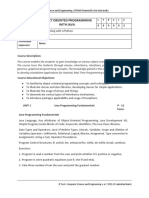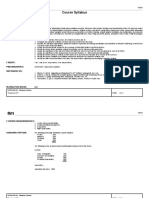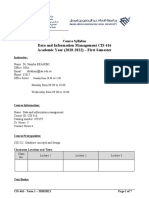0 ratings0% found this document useful (0 votes)
490 viewsSimplified Example Checksum Calculation
This document provides an example of calculating an internet checksum for a packet header. It describes taking the packet header bytes and forming 16-bit words, then summing the words using 32-bit arithmetic and taking the 1s complement of the result to get the checksum value. The checksum is added to the packet header and re-calculated at the receiver to check for errors.
Uploaded by
vinamp20Copyright
© © All Rights Reserved
Available Formats
Download as PDF, TXT or read online on Scribd
0 ratings0% found this document useful (0 votes)
490 viewsSimplified Example Checksum Calculation
This document provides an example of calculating an internet checksum for a packet header. It describes taking the packet header bytes and forming 16-bit words, then summing the words using 32-bit arithmetic and taking the 1s complement of the result to get the checksum value. The checksum is added to the packet header and re-calculated at the receiver to check for errors.
Uploaded by
vinamp20Copyright
© © All Rights Reserved
Available Formats
Download as PDF, TXT or read online on Scribd
You are on page 1/ 1
NET0183 Networks and Communications
Simplified example internet checksum calculation (example from the Net)
Assume the packet header is: 01 00 F2 03 F4 F5 F6 F7 00 00
(00 00 is the checksum to be calculated)
The first step is to form 16-bit words.
0100 F203 F4F5 F6F7
The second step is to calculate the sum using 32-bits.
0100 + F203 + F4F5 + F6F7 = 0002 DEEF
The third step is to add the carries (0002) to the 16-bit sum.
DEEF + 002 = DEF1
The fourth step is to take the complement. (1s becomes 0s and 0s become 1s)
~DEF1 = 210E
So the checksum is 21 0E.
The packet header is sent as: 01 00 F2 03 F4 F5 F6 F7 21 0E
At the receiver, the steps are repeated.
The first step is to form 16-bit words.
0100 F203 F4F5 F6F7 210E
The second step is to calculate the sum using 32-bits.
0100 + F203 + F4F5 + F6F7 + 210E = 0002 FFFD
The third step is to add the carries (0002) to the 16-bit sum.
FFFD + 0002 = FFFF which means that no error was detected.
(In 1s complement, zero is 0000 or FFFF.)
You might also like
- 1.INTRODUCTION A voice browser is a “device which interprets a (voice) markup language and is capable of generating voice output and/or interpreting voice input,and possibly other input/output modalities." The definition of a voice browser, above, is a broad one.The fact that the system deals with speech is obvious given the first word of the name,but what makes a software system that interacts with the user via speech a "browser"?The information that the system uses (for either domain data or dialog flow) is dynamic and comes somewhere from the Internet. From an end-user's perspective, the impetus is to provide a service similar to what graphical browsers of HTML and related technologies do today, but on devices that are not equipped with full-browsers or even the screens to support them. This situation is only exacerbated by the fact that much of today's content depends on the ability to run scripting languages and 3rd-party plNo ratings yet1.INTRODUCTION A voice browser is a “device which interprets a (voice) markup language and is capable of generating voice output and/or interpreting voice input,and possibly other input/output modalities." The definition of a voice browser, above, is a broad one.The fact that the system deals with speech is obvious given the first word of the name,but what makes a software system that interacts with the user via speech a "browser"?The information that the system uses (for either domain data or dialog flow) is dynamic and comes somewhere from the Internet. From an end-user's perspective, the impetus is to provide a service similar to what graphical browsers of HTML and related technologies do today, but on devices that are not equipped with full-browsers or even the screens to support them. This situation is only exacerbated by the fact that much of today's content depends on the ability to run scripting languages and 3rd-party pl24 pages
- Syllabus Algorithms and Complexity AY 2021-2022100% (1)Syllabus Algorithms and Complexity AY 2021-20228 pages
- Data Warehouse and Data Mining: Lab Manual100% (1)Data Warehouse and Data Mining: Lab Manual69 pages
- Computer Networking Course Syllabus GeneNo ratings yetComputer Networking Course Syllabus Gene4 pages
- Data Structure Using 'C' Hashing: Department of CSE & IT C.V. Raman College of Engineering BhubaneswarNo ratings yetData Structure Using 'C' Hashing: Department of CSE & IT C.V. Raman College of Engineering Bhubaneswar55 pages
- Networking Essentials 1206 Bac 2005230 Joy Ntinyari KimathiNo ratings yetNetworking Essentials 1206 Bac 2005230 Joy Ntinyari Kimathi5 pages
- Laboratory Activity Firewall IDS EncryptionNo ratings yetLaboratory Activity Firewall IDS Encryption4 pages
- Ccs0003 Computer Programming 1 Lec SyllabusNo ratings yetCcs0003 Computer Programming 1 Lec Syllabus6 pages
- CSC 409 Algorithms and Complexity AnalysisNo ratings yetCSC 409 Algorithms and Complexity Analysis223 pages
- Course Outline (Data Communication and Networking 1)No ratings yetCourse Outline (Data Communication and Networking 1)3 pages
- IT 12 Data Communication With Networking OBE Syllabus 1hourNo ratings yetIT 12 Data Communication With Networking OBE Syllabus 1hour8 pages
- PROF ELEC 2 - Integrative Programming and Technologies 2No ratings yetPROF ELEC 2 - Integrative Programming and Technologies 21 page
- Advanced Networking and Communication Systems CSIS 430 CGNo ratings yetAdvanced Networking and Communication Systems CSIS 430 CG6 pages
- COEN3193 - Data Communications - Syllabus-2S - AY2013-2014No ratings yetCOEN3193 - Data Communications - Syllabus-2S - AY2013-20145 pages
- CT106!3!2 Systems and Network Administration (VD1) 1 September 2019No ratings yetCT106!3!2 Systems and Network Administration (VD1) 1 September 20192 pages
- Keyboard Processing With Control Flow: Julius BancudNo ratings yetKeyboard Processing With Control Flow: Julius Bancud30 pages
- Computer Fundamentals & Programming (Exercise)No ratings yetComputer Fundamentals & Programming (Exercise)4 pages
- Basic Computer Skills Module 1 Hardware ConceptsNo ratings yetBasic Computer Skills Module 1 Hardware Concepts77 pages
- Packet Tracer For Beginners Tutorial Part 1No ratings yetPacket Tracer For Beginners Tutorial Part 11 page
- Lecture 1 - Introduction To Event Driven Programming100% (1)Lecture 1 - Introduction To Event Driven Programming27 pages
- COMP 20253 Application Development and Emerging Technologies100% (1)COMP 20253 Application Development and Emerging Technologies97 pages
- CSC 431 - Computer System Performance Evaluation (2 Units)No ratings yetCSC 431 - Computer System Performance Evaluation (2 Units)56 pages
- CIS416 - Data and Information Managment - Syllabus 2020-2021No ratings yetCIS416 - Data and Information Managment - Syllabus 2020-20217 pages
- Integrative Programming and Technologies 1No ratings yetIntegrative Programming and Technologies 128 pages
- Integrative Programming Technology - Integrative CodingNo ratings yetIntegrative Programming Technology - Integrative Coding45 pages
- 1.1.1.8 Packet Tracer - Using Traceroute To Discover The Network InstructionsNo ratings yet1.1.1.8 Packet Tracer - Using Traceroute To Discover The Network Instructions6 pages
- Lecture 2 Distributed and Parallel Computing CSE423No ratings yetLecture 2 Distributed and Parallel Computing CSE42323 pages
- 01 ELMS Activity 1 (In Computer Engineering As A Discipline)No ratings yet01 ELMS Activity 1 (In Computer Engineering As A Discipline)1 page
- 01-Short Description of The Internet ChecksumNo ratings yet01-Short Description of The Internet Checksum3 pages
- Short Description of The Internet Checksum IP Checksum DefinitionNo ratings yetShort Description of The Internet Checksum IP Checksum Definition4 pages
- Airtel Prepaid Postpaid Broadband 4G DTH Services in IndiaNo ratings yetAirtel Prepaid Postpaid Broadband 4G DTH Services in India1 page
- Solarwinds Technical Reference: Polled Object Identifiers For Orion NPM, Orion Nta, and Orion Ip Sla ManagerNo ratings yetSolarwinds Technical Reference: Polled Object Identifiers For Orion NPM, Orion Nta, and Orion Ip Sla Manager16 pages
- Mini Project Report: A Dissertation Submitted in Partial Fulfilment of The Requirements For The Award of Degree ofNo ratings yetMini Project Report: A Dissertation Submitted in Partial Fulfilment of The Requirements For The Award of Degree of38 pages
- How To Use PortSIP UC With Fanvil ProductNo ratings yetHow To Use PortSIP UC With Fanvil Product10 pages
- Using Netflows For Slow Portscan DetectionNo ratings yetUsing Netflows For Slow Portscan Detection102 pages
- 1623325248958-NED Division General Telephone Directory - 01062021No ratings yet1623325248958-NED Division General Telephone Directory - 0106202115 pages
- The Evolution of Social Media - How Did It Begin and Where Could It Go NextNo ratings yetThe Evolution of Social Media - How Did It Begin and Where Could It Go Next15 pages
- Electronic Reservation Slip: Journey DetailsNo ratings yetElectronic Reservation Slip: Journey Details1 page
























































































